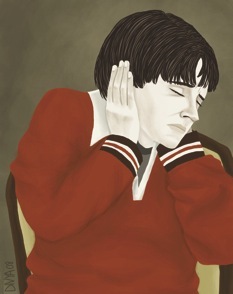Well, not really, but I will go through some of the things that stood out for me. It should also be noteworthy to mention that even if my opinions of the book were … less than satisfactory, I can still appreciate what he was going for. Or so I think. Oh well – this is the last post (I swear) that I will be writing about this book, so this horrid affair will soon be over. LET’S END IT (contains spoilers, proceed at your own risk)
The Internal and Interpersonal Conflicts
Theme: We can go to extreme measures to protect those that we love because having something to cherish in turns makes ourselves have greater strength, even if it means tearing down those around us.
Basically for the whole book, Faulkner uses his characters and specific motifs to develop this theme – but where it really comes out is the incestuous emotions of Quentin. His crazed obsessions with Caddy is perverse, but at the same time, is reflective of how much he loves her, and how willing he is to keep her “pure”. His therefore “pure” intent is actually what causes one of the major rifts in the family. Him being sent off to Harvard was not just a move to improve the family standing, but also an attempt to remove him from the toxic Southern environment. Except, we learn that the North is even more toxic.
On the other hand, we have Benjy’s love for Caddy – one that isn’t incestuous, but more of a son-mother variety. Caddy is often described as cradling Benjy, and she is often one of the few that can calm his fits. Ironically, it is these fits that become a binding staple of the story. The recurring motif is what brings things back into focus, particularly in later sections when parts of the plot being to unravel. Back to the theme, one can also interpret Benjy’s moans as a way of him protecting Caddy – not dissimilar from Quentin’s incestuous claims. Faulkner also makes references to how Benjy is quiet whenever Caddy smells like “leaves”. In the end, I still never got what he was going for.
Contrary to all of this, is Jason’s supposed lack of love – his apathetic views of the world, and how much he despairs about the incompetency of those around him. That said, I think that this is actually his way of revealing love, and in a way, by rejecting the things he cherish, he is protecting himself. We actually never get to see Jason’s inner thoughts, unlike how we are privy to Benjy and Quentin, and perhaps Faulkner was aiming at something significant here. In fact, Jason realizes the second half of the theme, in which he tears down those around him, to ultimately protect them (in a strange roundabout fashion). But maybe that is the complexity of life, all wrapped up in a torturous 321 pages.






